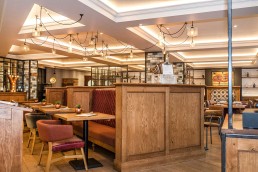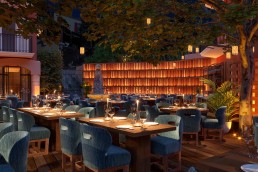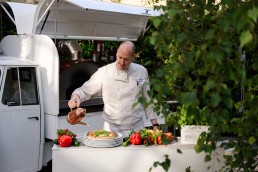H2R Design has unveiled its renovation of Anar, a Persian restaurant in Souk Madinat Jumeirah, Dubai. Refreshing the layout with natural flow and personality, the studio designed a space that maintained traditional spirit while adding modern twists and tones.
Situated at the heart of the Souk overlooking the Burj Al Arab and the tranquil water canal, Anar has for years attracted diners with its music, aromas and delectable cuisine. However, having been open for over a decade, H2R Design identified its need for an update and the replenishment of new energy to the restaurant’s presence.
The practice studied the colour palettes of Persian design including traditional art, music, language, tastes and flavours to delve deep into the cultural context and bring it forward to the modern world. They soon discovered that the space required a smooth balance between powerful hues, soft textures and rugged edges. With that as a goal, the design team curated interiors that brought icy lapis lazuli together with igneous burgundies, timbers, metallics and ambient lighting.
“Balance was an important aspect in the design inspiration. The historic Persian culture and kitchen are full of rich symbols, flaring qualities and temerity while the space attracted cooler undertones,” say Hasan and Husain Roomi, co-founders of H2R Design. “We weaved opposite sides of the spectrums harmoniously with subtle nods to the conventional styles while making it more relevant for this century.”
H2R’s mantra to go above and beyond is demonstrated with Anar’s design, starting from the grand courtyard entrance to the art tattooed on the walls, the symmetry on the floors and ceilings, and the carpentry and metallurgy throughout each corner of the restaurant. Upon reaching the courtyard, guests are greeted with a fountain and its blue geometric pattern tiles featured on the floor. The entrance ties in the outdoor seating spaces to the indoor interiors.
Inspired by Persian gardens, the seating area in the courtyard is decorated with suspended lanterns, lounge tables traditional screenings and calligraphy art to compliment the turquoise patterned stencils on the restaurant’s walls. This space allows diners to bask in outdoor ambience while listening to cultural music played in the background that matches the theme.
“We wanted to put some emphasis on the courtyard area by creating the central water feature surrounded by beautiful Persian inspired tiles,” Roomi explains. “This is a more tranquil lounging space compared to the rest of the restaurant, which is full of dramatic features. This way we modernised Anar, by not allowing it to go down the typical design route whilst still maintaining the old-world grace.”
The interiors of the restaurant are divided into three segments in accordance of their functional attributes. The courtyard entrance leads to the welcome area and the bar; the left side houses a traditional oven (where fresh breads and dough-based delicacies are made) and a semi-private dining area to create a more intimate dining experience; and the right side opens up to a spacious hall to cater for larger parties.
An open modern design Tandoor kitchen also allows guest to watch chefs prepare traditional bread. Terracotta tiles were added as the backsplash to create a traditional look while functioning as a heat resistant material absorbing higher temperatures and reducing cracking. To incorporate an Arabic architectural element, Mashrabiya panels were incorporated in the open kitchen with a bronze antique finish, while perforated mesh in a copper finish was also used for interior detailing, joinery and trims on the walls.
Inside the right side of the restaurant, the ceiling has a patterned metalwork finish, reflecting as an elaborate ornamentation while providing balance and symmetry to the overall design. This idea is further expressed on the floor design, which adds vibrancy with fresh white ceramic mosaic tiles against the lively colours of aqua and crimson furniture.
“Art was another focal point for us and the client in the redesign of Anar. In addition to the framed wall art pieces, we created symbolic mint stencils across the exterior walls tying in the both dimensions of the restaurant collectively into one,” says Room. “The client also commissioned an Iranian artist who painted lively murals to enrich the space with splashes of colour and whimsy. Creating a canvas for the art, we used travertine on the walls to keep it quite earthy and to allow for the colours to pop out playfully.”
Modern yet Persian-inspired lighting was incorporated throughout the restaurant to create sanguine glows and warmth, while other key features of the redesign include antique smoky mirrors with a mesh of brass, developed by the contractor and inspired by the traditional wooden archways added by H2R Design. The fabrics of the furniture are all Persian-inspired in colour and pattern, though H2R didn’t want to be overly traditional, and as a result, the colours are animated and full of energy.
Textured walls were developed to embody a natural feel throughout the space too, and were livened up with different applications and surfaces to add depth and variation. The neutral tones were also maintained to allow the shades of the feature tiles, fabrics of the furniture and artwork to pop out.
Elsewhere, a luxurious bar top was built using blue marble to accentuate the turquoise and blues of Persian design. Lightly stained oak wood was used for the furniture, which is not traditional to Persian design; however, a contrast of lighter tones was needed to complement the floors. The floors of the larger space are carpeted with beige and brown porcelain tiles sourced locally, maintaining the cohesive neutral earthy vibe throughout, and allowing colours from other elements to be highlighted.
To cater for Anar’s entertainment programme, where DJ’s and bands are brought in to create a lively experience, flexible and movable furniture pieces were installed for easy accessibility.
CREDITS
Photography: © Alex Jeffries
Related Posts
16 April 2025
Hotel Indigo York partners with Pasta Evangelists
14 April 2025



